Shadi Abdel Salam
(1930 – 1986)
"I think that the people of my country are ignorant of our history and I feel that it is my mission to make them know some of it and let the others go on with the rest. I regard cinema not as a consumerist art, but as a historical document for next generations."
Shadi Abdel Salam 1986
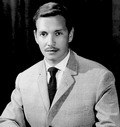
Shadi Abdel Salam
(1930 – 1986)
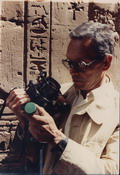
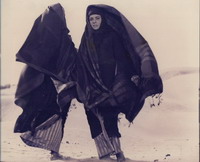
nadia Lotfi in The Mummy
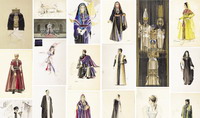
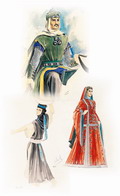
Costumes Scketched by Shadi Abdel Salam
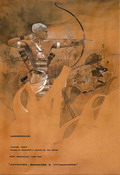
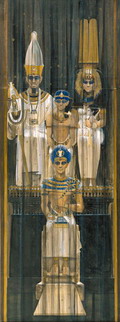
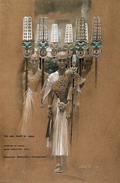
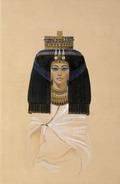
Some of Shadi's Scketches for Akhenaton
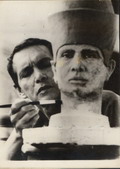
Working on Akhenaton, The Tragedy of the Great House (Ikhnâtoun)
Shadi Abdel Salam, who directed only one full-length feature movie, has become firmly established as one of the most important Egyptian directors and his reputation has transcended local borders to international fame. The memory of this great artist is still engraved in the minds and hearts of his disciples who uphold the idol’s vision, adhere to his views and are still trying to bring his deferred dream Akhenaton, the Tragedy of the Great House (Ikhnâtoun) to light.
Abdel Salam was born on 15 March 1930 in Alexandria to a family that originally came from Upper Egypt. He received his education at Victoria College. It seems to have played an important role in shaping his consciousness for when he started writing his scripts, he found out that he could only write them in English because English had infiltrated unawares into his consciousness as it was the language of the education he received in his formative years. He would then seek the help of some one to translate his creations into Arabic. Victoria College also seems to have fostered his love for drama as his art and drama teacher encouraged him a lot and his headmaster recommended him on the strength of those two points.
It was also during childhood that he started drawing and painting but was neither encouraged nor rebuked by his family who did not appreciate the arts. As a young boy, he was eager to read, but his father’s library, which only included dry law and history books, did not appeal to his imagination. At the age of thirteen, he was bed-ridden for two whole years because his heart was endangered by his abnormal rapid growth. It was during this period that he read avidly to kill the long monotonous hours of the day. Those two years gave him ample time to broaden his horizons through reading and to develop his drawing talent.
After graduating from Victoria College, he travelled to Paris, London and Rome to study drama but came back to Egypt without achieving his aim. On his return, he joined the Architecture Department of the Faculty of Fine Arts, Cairo University from which he graduated in 1954. After graduation, he went back to England to study drama in 1956 in order to fulfill his old dream.
He started his career in cinema by working as an assistant director to Salah Abou Seif, who happened to be his neighbour at Zamalek in Cairo. During the first film, The Thug (el Futuwwa)(57/8), he was more or less a spectator and all he did was jot down the duration of each shot. He later worked as an assistant director to Henri Barakat and Helmi Halim. It was during his work as an assistant director to the latter in A Love Story (Qessat houbb) that his ability to create the set design was discovered when the designer happenedto be absent and he was asked to replace him. Many filmmakers were impressed by his décor for that film and he subsequently received many offers. In fact, he is still considered one of the most extraordinary Egyptian set- and costume-designers.
It was his profound and intense knowledge of the environment and civilization of different historical epochs which made him excel designing the sets and costumes of historical films. He worked not only on Egyptian films, like Oh Islam! (Wa Islamah) in 1961 by Andrew Marton, Almaz and Abdou el Hamouli (Almaz we ‘Abdou el Hamoulî) in 1962 by Helmy Rafla, Saladin (El Nâsir Salah Eddine) in 1963 by Youssef Chahine, Shafika the Copt (Shafiqah el qibtiyyah) in 1963 by Hassan el Emam, Rabea el Adweya (Râb’a el ‘Adawiyyah) in 1963 by Niazi Mustafa and Prince of Cunning (Amîr el daha’) in 1964 by Henri Barakat, but also designed the costumes and décor for foreign films.
For example, in 1964, he was to take part in setting the décor of Cleopatra. But it seems that this experience was not fruitful for Abdel Salam never got close to the world of Joseph Mankiewiz, the director of this movie. In 1965, he was appointed as consultant for the historical set and costume designs of the film Pharaoh by the Polish director Kawalerowicz. His experience in this film was quite different from the former as Kawalerowicz taught him a great deal and gave him the golden opportunity of standing behind the camera and directing one of the shots of the film. Speaking of the impact of these two experiences on him, Abdel Salam beautifully compares working with Mankiewiz to working in an assembly line in a factory, while working with Kawalerowicz to going to school.
In 1967 he designed the décor and costumes of the documentary film Mankind’s Fight for Survival by the Italian director Roberto Rossellini. The influence of Rossellini on Abdel Salam seems to have surpassed the influence of any of the other directors for it was after the completion of this film that Abdel Salam decided to become a director.
Interestingly, Rossellini not only encouraged him to become a director, but also helped him in executing his first project, The Mummy (el moumya’): the story goes that when Abdel Salam proposed his idea to Rossellini, who was staying in Cairo at the invitation of Tharwat Okasha, Minister of Culture, to supervise the founding of a cultural centre for cinema, he was enamoured with it and approached the enlightened Tharwat Okasha who immediately adopted the project. Naguib Mahfouz, Chair of the Cinema Institution then, also played an important role in funding the film.
Thus, in 1969, Abdel Salam started directing his first and only full-length feature, The Mummy (el moumya’) also known as The Night of the Counting of the Years with the assistance of Abdel Aziz Fahmi and Mustafa Emam as photographers, Samir Auf as second assistant and Salah Marei and Onsi Abou-Seif as set designers. The film tells the story of Wanis who learns after the death of his father, the chief of the Hurrabat tribe, that the tribe makes its living from the theft of the mummies of the royal tombs that lie in the bowels of the mountains near Thebes. Wanis is torn apart between his duty towards his country and his loyalty to his tribe but eventually decides to disclose the secret of the place to the archaeologists who are excavating nearby.
The visual impact the film leaves on the spectator is ever-lasting as Abdel Salam aimed at expressing the essence of things and sought artistic narration through image, architecture, light and colour rather than through dramatic action, literary narration or linguistic dialogues. The abstraction, silence, slow rhythm, and dignified movement of the actors allow the spectator to focus on the visual elements and reflect on their dramatic value. Moreover, Abdel Salam’s choice of classical Arabic contributed to the monumental influence of the film which stands out as a great epic peopled with larger-than-life characters.
His next project on Akhenaton was never accomplished, in spite of twelve years of intensive preparation and research, due to lack of Egyptian financing for this ambitious and expensive project. Sadly enough, Abdel Salam designed the drawings of the film, and diligently supervised all the designs that were carried out in his atelier by Salah Marei and Onsi Abu Seif, his students who later became his colleagues. Although Abdel Salam received a number of offers from foreigners who were more than willing to produce his outstanding project, he insisted on Egyptian funding as he firmly believed that the film had to be fully Egyptian. Speaking of those hard times in his life, he says:
Throughout my life, I have protected myself from commercial pollution and enhanced it with reading, research and education. I have gone through moments of extreme depression because I didn’t work; time is flying and my head is full of visions which need to be brought to light. I want to do something worthwhile but lack of facilities always hampers my dreams. I wish the government would take me under its wing. For me, work is life. All day long, I read, write, draw, sculpt, take photos and store everything in my mind in preparation for the day on which I would stand behind the camera to shoot Akhenaton. (From interviews with Abdel Salam collected by Magdi Abdel Rahman)
Abdel Salam’s inability to bring his feature movie Akhenaton, the Tragedy of the Great House to light made him channel his energy towards making short films and documentaries. In 1970, he directed the short fiction movie The Eloquent Peasant (el Fallâh el fasîh) and the documentaries Horizons (Afâq), Armies of the Sun (Gîyoush el shams), Tutankhamun’s Chair (Korsî Tout Ankh Amon), The Pyramids and Before it (el ahrâm wa ma qablâha) and Ramsis II (Ramsîs el thânî) in 1972, 74, 82, 84 and 86 respectively. The most notable characteristic of those short movies and documentaries is their emphasis on the visual element, something which Abdel Salam seemed to be obsessed with throughout his career in cinema for even when he was appointed as head of the Department of Experimental Film, which constituted an under-section of the Public Documentary Film Centre in 1968, he attempted to make the image the cornerstone of experimental films. In fact, the most important innovation of the short films produced by Abdel Salam’s department was that they did not comment on the images, which had been a habitual practice in all Egyptian documentaries. The image alone was supposed to convey the meaning of the film. Abdel Salam’s short film Horizons, which depicts without commentary a panorama of contemporary artistic activities in the country ranging from music, ballet to drama is a case in point.
During his chairmanship, the centre became a venue for experimentation for young ambitious filmmakers, among whom were Hisham el Nahas, Daoud Abdel Sayed, Atif el Bakry, Samir Auf, Mohamed Shaaban and Ibrahim el Mugi, who were lovingly encouraged to give vent to their artistic expressions.
Abdel Salami’s talent made him accumulate a long list of local and international awards among which are: Georges Sadoul’s Award for The Mummy (el moumya’) in 1970, The Critics’ Award from Carthage Festival for The Mummy (el moumya’) in 1970, The Lion of San Marc Award from Venice Film Festival for Documentaries for The Eloquent Peasant (el Fallâh el fasîh) in 1970, The Second Award from Leipzig for The Farewell Hymn with others in 1970, Sidalic’s Great Award for the Best Documentary for The Eloquent Peasant (el Fallâh el fasîh), Screenplay and Directing Award from the Egyptian Festival for Short Films and Documentaries in 1971, Golden Film Award from Fladolida Festival in Spain in 1971 for The Eloquent Peasant (el Fallâh el fasîh), a Lifetime Achievement Award from the Catholic Centre in Egypt in 1975, Screenplay and Directing Award from the Egyptian Festival for Short Films and Documentaries for Horizons (Afâq) in 1975, Directing Award from Egyptian Festival for Short Films and Documentaries for Armies of the Sun in 1976, Directing and Costume Designing Awards from The Film Association for Armies of the Sun (Gîyoush el shams) in 1976, Award of Association of Arab Critics in Europe from Toulon Festival in 1976, State’s Encouragement Award for Tutankahamon’s Chair (Korsî Tout Ankh Amon) in 1985, and a Lifetime Award from the African Cinema Festival held in Italy in 1982.
Abdel Salam died at the age of fifty-six of cancer in Cairo on 8 October 1986 without having realized his dream of directing Akhenaton, The Tragedy of the Great House (Ikhnâtoun).
His dedicated friends and disciples immediately founded The Association of the Friends of Shadi Abdel Salam after his death in 1986 with the ultimate aim of preserving the heritage he left behind. They managed to collect his entire legacy, which included his sketches, paintings, parts of his scripts and personal library. On celebrating the Diamond Jubilee of Shadi Abdel Salam, the Bibliotheca Alexandrina commemorated the birth of this great Alexandrian artist by acquiring his valuable legacy and putting it on permanent display in a hall that is called the World of Shadi Abdel Salam.
Filmography:
Films that he directed:
1969: The Mummy (The Night of the Counting of the Years) (el moumya’)
| 1969: The Mummy (The Night of the Counting of the Years) (el moumya’) |
1970: The Eloquent Peasant (el Fallâh el fasîh)
1972: Horizons (Afâq)
1974: Armies of the Sun (Gîyoush el shams)
1982: Tutankhamon's Chair (Korsî Tout Ankh Amon)
1984: The Pyramids and before it (el ahrâm wa ma qablâha)
1986: Ramsis II (Ramsîs el thânî)
A film that he took part in directing:
1970: The Farewell Hymn (Ounshoudat el wada’)
Incomplete films:
1979: The Fortress (el hîsn)
1980: El Dandaraweya (el dandaraweyyah)
A screenplay that was not shot:
Akhenaton, The Tragedy of the Great House (Ikhnâtoun)
References:
- Abdel Rahman, Magdi. Yawm an Touhsâ el Sinîn. El Qâhira (Special Issue) 145(1994).
- Daoud, Abdel Ghani. El Rahloun fe Ma̓at ‘Âm. Cairo: Wezârat el Thaqafah, 1997.
- Hamouda, Sahar & Colin Clement. Victoria College: A History Revealed. Cairo: AUC Press, 2002.
- Shafik, Viola. Arab Cinema: History and Cultural Identity. Cairo: AUC Press, 1998.
- Lewis, Edward. "Shadi Abdel Salam: A Man of Many Talents". Alex-Med Newsletter 4(2005): 14-5.
- Marei, Salah & Magda Wassef. Chadi Abdel Salam: Le Pharaon du Cinéma Egyptien. Paris: Institut du Monde Arabe, 1996.
- The World of Shadi Abdel Salam. Alexandria: Bibliotheca Alexandrina, 2005.
- In 1967 he designed the decor and costumes of the documentary film Mankind’s Fight for Survival by the Italian director Roberto Rossellini.

